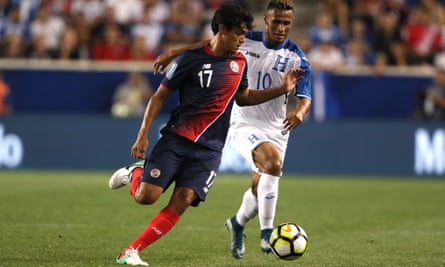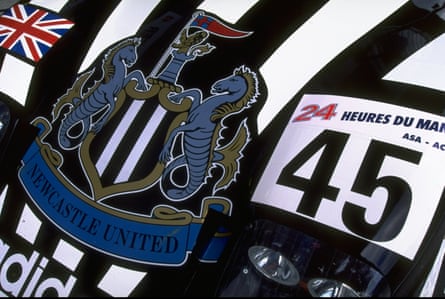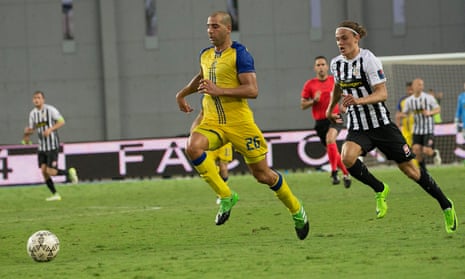“FK Partizan, current Serbian league and cup holders, have two Nemanja Miletićs in their squad,” exclaims Leo Crnogorcevic. “Both were born in 1991 and neither has a middle name. It appears as if they have collectively decided to be referred to as Nemanja ‘G’ and Nemanja ‘R’ after their fathers’ first names, respectively (in turn showcasing what a patriarchal society we live, although that’s a matter for another time). My question therefore is: has a club ever had two (or more) players with the exact same name in their squad, and how have they differentiated them?”
This isn’t quite so rare as you might think Leo, particularly in Israel. Here’s Ciaran Hannigan-Purcell to get the ball rolling. “In June 2015, Maccabi Tel Aviv bought the journeyman defender Tal Ben Haim to go with the young winger already at the club, Tal Ben Haim. The younger and less prestigious winger went by the subtly different Tal Ben Chaim from then on on his shirts, though Uefa reports record his name as Tal Ben Haim II. As they have over a hundred caps for Israel between them, they’ve probably also been on the pitch for the national team at the same time, too.”
Ravid Alon points out that there are also two Shlomi Azulay playing for Ironi Kiryat Shmona in the Israeli Premier League. “One of them has a middle name, so in the IFA’s official lists they are easily distinguishable, though both wear just Azulay on their shirt.”
Over to the Russian Premier League now where Marat Airapetian takes us back to Lokomotiv Moscow in 2002 and 2003. “There were two players by the name of Sergei Ovchinnikov. One was a famous and influential goalkeeper, nicknamed The Boss, with 35 games for the national side. Another, a young attacker who ended up having an unremarkable career. The two were differentiated exactly like in the original Serbian example – by patronym, their fathers’ first name, which is quite common in Russia. So, Sergei Ivanovich Ovchinnikov was keeping goal, and Sergei Vladimirovich Ovchinnikov failed to score in his four appearances. By the way, in 2002 Locomotiv won the League!”
Andy Boyd has a tale of two Harrys. “There was an unusual case at Scarborough in the 1970s when two players called Harry Dunn were both at the club,” he writes. “The first Harry Dunn staggeringly made more than 900 appearances for them, with his namesake given the fictitious middle initial ‘A’ in a bid to distinguish between them – he would long be known to supporters as Harry A Dunn thereafter.”
Oliver Robinson picks up the baton. “Parisian club Red Star (quite ironic with regards to Partizan) had two Pierrick Cros in their squad. One of them, the defender born in 1992, played 108 games for the club. However, the other is yet to make his league debut. Slightly differently, Everton have had two legends who go by the same name, Alex Young. The more known Alexander Young played for Everton through the sixties and was known as the Golden Vision. However the other played for the Toffees in the 1900s, making 275 league appearances. His name was Alexander Simpson Young although he was known as Sandy Young.” More on him here.
And last, but very much not least, here’s Önder Susam: “I remember the dark ages of Turkish football when players with the same first name were classified as ‘Küçük’ (small/young) and ‘Büyük’ (big/old). Emre Belözoğlu was once called Küçük Emre as he was younger than the defender Emre Aşık. In the nineties this trend started to disappear as players’ surnames were used more often (and names were printed on shirts) but I remember commentators calling Hakan Şükür ‘Büyük Hakan’ (Hakan the old) and Hakan Ünsal ‘Küçük Hakan’.
“I vaguely recall hearing about my hometown’s team Bursaspor having three players with the first name Sedat and, despite having different surnames, they were called ‘Big Sedat’, ‘Little Sedat’ and, strangely, ‘Sedat 3’. Even after the first two Sedats left the club, Sedat 3 was called Sedat 3 (real name Sedat Özden) and in an interview (in Turkish) he mentions not being able to convince people that he actually has a real surname and having to introduce himself as Sedat Üç (3).”
Politically-inspired footballer names
“Marx Lenin has just signed his first contract with Flamengo,” wrote Nick Howe Bukowski. “Unfortunately he doesn’t seem to be a left winger (at least on the pitch that is). Are there any other footballers named after political leaders and thinkers?”
Well Nick, it seems parents of the footballers of the future can’t help but look to politicians for inspiration when it comes to naming their children. The Soviet Union and Russia especially so for those in Latin America. As Stijn points out: “Venezuela has Stalin Rivas, Ecuador has Lenin Porozo and Costa Rica has Yeltsin Tejeda (who was once rumoured to be a target for FC Ural from Yekaterinburg, the hometown of Boris Yeltsin).

“On the other hand, you can’t go wrong with an American president. There’s Jhon Kennedy Hurtado from Colombia, Richard Nixon Quiñónez from Ecuador and Clinton Mata from Angola, born a mere four days after Bill was elected. Similar story on Madeira in 1985, where two weeks after Reagan’s second inauguration, a certain Cristiano Ronaldo dos Santos Aveiro was born.”
This is courtesy of Tim Vickery, who spoke about these players on BBC 5 Live’s World Football Phone In a couple of years ago: “Trindade in Brazil can boast a Mahatma Gandhi. He’s picked up nine yellow cards and one red in 994 minutes of senior club football, so is not really adhering to his namesake’s principles.” And I’m not sure if this one counts, but while at Atlético Goianiense in 2013, Gandhi played on the same team as John Lennon, writes Ian Graham.
Then there’s …
@TheKnowledge_GU players named after political leaders, you ask..... https://t.co/dihzTgXBA6
— James Straughan (@jastraughan85) July 18, 2017
Finally, Stijn is back to tell us that in Abidjan in the year 1992, two parents decided to name their newborn after a French socialist leader and the first Holy Roman Emperor. Jores Charlemagne Okore would become a Danish international and must be the hipster choice in this lot. Oh, and not forgetting Norman Conquest. OK, we know it’s inspired by an invasion and not a political leader but it was too good to let it slide.
Strange football club sidelines (part II)
“Having seen last week’s entry about Liverpool FC’s race car, it sparked a memory that Newcastle United also used to have a racing team – or at least had a race car that was entered in a few events,” writes Don Thomas. “It was a Lister Storm and raced in the 1996 season. I can’t fathom what favourable commercial outcome was anticipated through such activity, but I’m not sure the chairman at the time gave much thought to such thing.”
Gavin Reed has done some additional digging on this very subject and it appears Newcastle did indeed come over all Days of Thunder back in the 1990s. “I can only find evidence of it having entered the 24 hours of Daytona event and the 24 hours of Le Mans event, though possibly there were others. Appropriately for the fortunes of my beloved club around that time, it crashed out of both events.” For further reading, here’s a piece from the Evening Chronicle. There are the pictures of the smashed-up car here too.

And in answer to our request for information on what happened to the club-branded Superleague Formula cars when the event went belly-up, here’s Adam Weller: “I don’t know about the Liverpool car specifically but I can tell you that some of the Superleague Formula cars – known as the Panoz DP09 – still race to this day in a series called BOSS GP. The series is open to relatively modern Formula One cars, GP2/F2 machinery, IndyCars and almost any other single seater you could care to mention. Here’s a photo gallery from their site, where you can see a couple of the cars in action. The liveries are slightly different from the football club era, as the organisers unsuccessfully tried to revamp the concept to that of a ‘nations cup’.
“The car in orange and silver Dutch colours is the former PSV Eindhoven car, and the one in purple represented Anderlecht. I would also say that a few cars are likely still floating around with the teams that ran them for the football squads. A lot of teams may still have their chassis; I couldn’t tell you why, but a lot of the time they just hold on to cars.”
Away from the dirty fumes of motorsport sidelines, Ross Heaviside got in touch with this. “Trabzonspor announced plans to build a hydroelectric plant in Turkey in 2012 – their chairman is a civil engineer. I can’t find the most recent news on it but there was definitely work done on the project.”
Knowledge archive
“If you take a look at the teams playing in the Premier League for the 2001-02 season, you see nine different endings on 12 teams with more than one word in their name (Villa, Rovers, Wanderers, Athletic, County, Town, United (4), City, Hotspur). Has the English top flight ever had a more diverse field of two-word teams?” asked Eric Jonathan Martin in 2001.
“Pah!” was Andy Marsh’s response to Eric’s innocent inquiry. “In 1892-93 there were 11 different endings in the First Division, and in those days there were only 16 teams in the top division.” And to show what a know-all he was, he named them: Villa, Albion, Wednesday, Forest, Stanley, County, Wanderers, North End, City, Rovers and Heath.
Graham Lawton still trumped him, mind. “In 1920-21 there were 12 different endings in a 22-team division,” he writes. “Three Uniteds, two Citys and a Wanderers, Hotspur, Villa, Rovers, Albion, North End, Town, Athletic, County, Park Avenue.” Diversity indeed.
Can you help?
“I was looking through the records for my club, Sheffield Wednesday, and I noticed that the record for oldest goalscorer is held by goalie Mark Crossley, who scored an injury-time header when we drew 3-3 with Southampton in 2006,” mails Adrian Worton. “How many other clubs have a goalscoring record held by their goalkeeper?”
“Three prominent players – Ebi Smolarek (47 caps for Poland), Eusebio di Francesco (12 caps for Italy) and Eusebio Sacristán (15 caps for Spain) – were named after Portuguese legend Eusébio,” points out Phil Farrell. “All three went on to become successful internationals. Is there any player who more than three other international footballers have been named after?”
“Back on 5 September 1993, SK Brann drew 0-0 against IK Start,” begins Tor Henrik von der Ohe. “The next time SK Brann drew 0-0 in a league game was 1 June 1997 against SFK Lyn; in almost four years they played 89 league games where at least one of the teams scored. Is this a record in the top league of any country?
“While reading this article, I noticed that Huddersfield Town have signed more players from Sheffield United than any other club, with a grand total of 14, but they’ve never paid a penny – they were all free transfers,” writes Alex Lancaster. “Is this a record? Has any professional club ever signed more players from a single team without paying a penny?”
- Send questions and answers to knowledge@theguardian.com or tweet @TheKnowledge_GU
